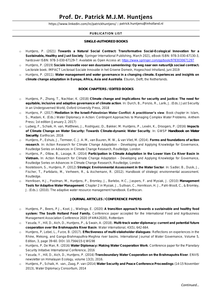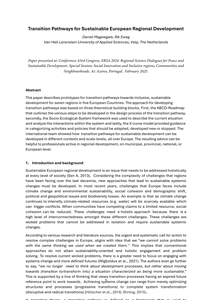The Zhanghe irrigation system (ZIS) is located in the Yangtze River Basin approximately 200 km west of Wuhan in Hubei Province. The reservoir was designed for multiple uses—irrigation, flood control, domestic water supply, industrial use, aquaculture, and hydropower. Over a period of more than 30 years a steadily increasing amount of water has been transferred from irrigation to other uses. Activities on the part of government, irrigation system managers, and farmers made this transfer possible with only modest decline in rice production. Most important factor was the steady increase in rice yields. The water pricing system provided an incentive for ZIS to reduce irrigation releases. With the steady decline in releases, farmers were forced to find ways to save water. Farmers improved existing ponds and built new ones to store water (improved infrastructure). Access to pond water on demand facilitated the adoption of alternate wetting and drying (technology) particularly in dry years. The establishment of volumetric pricing (price policy) and water user associations (institutions) may also have provided incentives for adoption of AWD, but more research is needed to establish their impact. These activities taken together can be seen as potentially complementary measures. Farmers received no direct compensation for the transfer of water, but recently farm taxes have been reduced or altogether abolished. Further reduction in water releases from the ZIS reservoir could adversely affect rice production in normal or dry years.
DOCUMENT
Both climate change and human activity are the important drivers that can change hydrological cycle routs and affect the features of hydrological drought in river basins. The current study selects the Zayandeh Rud river Basin as a case study region in which to evaluate the influences of climate alteration and human activity on meteorological and hydrological drought based on the Standardized Precipitation Index (SPI) and Standardized Runoff Index (SRI) on different time scales. The generated local climatic data of future years (2006–2040), (2041–2075) and (2076–2100) under the severest scenario (RCP 8.5) from the CMIP5 climate model are selected and used for the hydrology model and water allocation model of WEAP to construct hydrological drought which also consider human activities. The results indicate that significant meteorological drought is expected to occur in the winter and spring months of January to June. However, the driest month for hydrological drought is in the summer and autumn (July to December) (e.g. no changes in seasonality of droughts compared to historic period). It is concluded that, in the results of this work, the human influences on projected hydrological drought have been outlined; they had been missed in many projections for future hydrological drought. However, this study confirms the previous study (Bierkens et al. 2012) which mentioned that human influences can account for future hydrological drought in areas of Asia, the Middle East and the Mediterranean. The results attained in this study are beneficial for examining how hydrological drought characterizations respond to climate alteration and human activity on several time scales, thereby providing scientific information for drought predicting and water resources management over various time scales under non-stationary circumstances.
DOCUMENT
Legislation in the Netherlands requires routine analysis of drinking water samples for cultivable Legionella species from high-priority installations. A field study was conducted to investigate the presence of Legionella species in thermostatic shower mixer taps. Water samples and the interior of ten thermostatic shower mixer taps were investigated for cultivable Legionella species. In seven cases, Legionella species was found in at least one of the samples. In four cases, Legionella species was detected in the biofilm on the thermostatic shower mixer taps interior, with the highest values on rubber parts, and in five cases in the cold supply water. These results show that thermostatic shower mixer taps can play a role in exceeding the threshold limit for cultivable Legionella species, but the cold supply water can also be responsible. Practical implications: This study showed that contamination of thermostatic shower mixer taps (TSMTs) with Legionella spp. was frequently observed in combination with contamination of the water system. Consequently, a combined focus is necessary to prevent the proliferation of cultivable Legionella spp. in TSMTs. In addition, the results also demonstrated that biofilms on rubbers inside the TSMT had high numbers of Legionella spp., probably because rubber contains relatively high concentrations of biodegradable substrates. Therefore, improvement of the rubber materials is necessary to reduce the proliferation of cultivable Legionella spp. in TSMTs.
DOCUMENT

This paper focuses on the topical and problematic area of social innovations. The aim of this paper is to develop an original approach to the allocation of social innovations, taking into account characteristics such as the degree of state participation, the scope of application, the type of initiations as well as the degree of novelty, which will be elaborated on further in this article. In order to achieve this goal, the forty-two most successful social innovations were identified and systematized. The results of this study demonstrated that 73.5% of social innovations are privately funded, most of them operating on an international level with a high degree of novelty. Moreover, 81% of all social innovations are civic initiatives. Social innovations play an important role in the growth of both developed and less developed countries alike as highlighted in our extensive analysis
DOCUMENT

Background: Early childhood caries is considered one of the most prevalent diseases in childhood, affecting almost half of preschool-age children globally. In the Netherlands, approximately one-third of children aged 5 years already have dental caries, and dental care providers experience problems reaching out to these children. Objective: Within the proposed trial, we aim to test the hypothesis that, compared to children who receive usual care, children who receive the Toddler Oral Health Intervention as add-on care will have a reduced cumulative caries incidence and caries incidence density at the age of 48 months. Methods: This pragmatic, 2-arm, individually randomized controlled trial is being conducted in the Netherlands and has been approved by the Medical Ethics Research Board of University Medical Center Utrecht. Parents with children aged 6 to 12 months attending 1 of the 9 selected well-baby clinics are invited to participate. Only healthy children (ie, not requiring any form of specialized health care) with parents that have sufficient command of the Dutch language and have no plans to move outside the well-baby clinic region are eligible. Both groups receive conventional oral health education in well-baby clinics during regular well-baby clinic visits between the ages of 6 to 48 months. After concealed random allocation of interventions, the intervention group also receives the Toddler Oral Health Intervention from an oral health coach. The Toddler Oral Health Intervention combines behavioral interventions of proven effectiveness in caries prevention. Data are collected at baseline, at 24 months, and at 48 months. The primary study endpoint is cumulative caries incidence for children aged 48 months, and will be analyzed according to the intention-to-treat principle. For children aged 48 months, the balance between costs and effects of the Toddler Oral Health Intervention will be evaluated, and for children aged 24 months, the effects of the Toddler Oral Health Intervention on behavioral determinants, alongside cumulative caries incidence, will be compared. Results: The first parent-child dyads were enrolled in June 2017, and recruitment was finished in June 2019. We enrolled 402 parent-child dyads. Conclusions: All follow-up interventions and data collection will be completed by the end of 2022, and the trial results are expected soon thereafter. Results will be shared at international conferences and via peer-reviewed publication.
LINK
Immense beyond imagination, the untamed rainforests of western New Guinea represent a biodiversity hotspot, home to several unique species of flora and fauna. The territory’s astonishing beauty and diversity is underpinned by a stunning array of natural resources. The island is also home to many indigenous communities practicing hundreds of local languages and traditions and depending on their natural environment for maintaining their traditional livelihoods, identity and culture. The territory’s much-contested decolonization process in the 1950-60s led to widespread discontent among indigenous Papuans and gave rise to persistent dissent from Indonesian rule, routinely met with disproportionately violent action by Indonesian security forces. Adding to these longstanding colonial ills and grievances, indigenous Papuan communities also struggle to grapple with inequitable allocation of land and resources, extreme pollution and environmental degradation caused by the mining and palm oil sectors. In the meantime, climate-exacerbated weather events have become more frequent in the region creating new tensions by putting an additional strain on natural resources and thus leading to an increased level of insecurity and inequality. In particular, these challenges have a disproportionate and profound impact on indigenous Papuan women, whose native lands are deeply embedded in their cultural and ethnic identity, and who are dependent on access to land to carry out their prescribed roles. Displacement also puts women at further risk of violence. Adding to sexual violence and displacement experienced by indigenous Papuan women, the loss of traditional lands and resources has been identified as having a singularly negative impact on women as it impedes their empowerment and makes them vulnerable to continued violence. The Papuan experience thus serves as a timely illustration to exemplify how environmental factors, such as resource extraction and climate change, not only amplify vulnerabilities and exacerbate pre-existing inequalities stemming from colonial times, they also give rise to gendered consequences flowing from large-scale degradation and loss of the natural environment.
DOCUMENT

De publicatielijst bevat alle publicaties waar Patrick Huntjens aan bijgedragen heeft in de periode 1998 - 2021
DOCUMENT

We summarize what we assess as the past year's most important findings within climate change research: limits to adaptation, vulnerability hotspots, new threats coming from the climate–health nexus, climate (im)mobility and security, sustainable practices for land use and finance, losses and damages, inclusive societal climate decisions and ways to overcome structural barriers to accelerate mitigation and limit global warming to below 2°C.
MULTIFILE

Background: Although the general assumption is that patients with rheumatoid arthritis (RA) have decreased levels of physical activity, no review has addressed whether this assumption is correct. Methods: Our objective was to systematically review the literature for physical activity levels and aerobic capacity (VO2max). in patients with (RA), compared to healthy controls and a reference population. Studies investigating physical activity, energy expenditure or aerobic capacity in patients with RA were included. Twelve studies met our inclusion criteria. Results: In one study that used doubly labeled water, the gold standard measure, physical activity energy expenditure of patients with RA was significantly decreased. Five studies examined aerobic capacity. Contradictory evidence was found that patients with RA have lower VO2max than controls, but when compared to normative values, patients scored below the 10th percentile. In general, it appears that patients with RA spend more time in light and moderate activities and less in vigorous activities than controls. Conclusion: Patients with RA appear to have significantly decreased energy expenditure, very low aerobic capacity compared to normative values and spend less time in vigorous activities than controls
DOCUMENT

This paper describes prototypes for transition pathways towards inclusive, sustainable development for seven regions in five European Countries. The approach for developing transition pathways was based on three theoretical building blocks. First, the ABCD-Roadmap that outlines the various steps to be developed in the design process of the transition pathway, secondly, the Socio-Ecological-System framework was used to describe the current situation and analyze the interactions within the system and lastly, the X-curve model provided guidance in categorizing activities and policies that should be adapted, developed new or stopped. The international team showed how transition pathways for sustainable development can be developed in different contexts and scale levels, all over Europe. The resulting advice can be helpful to professionals active in regional development, on municipal, provincial, national, or European level.
DOCUMENT
